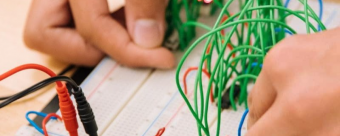Microcontroller Programming Stm32 Timers Pwm Can Bus Protocol
Tags: Microcontroller
Learn STM32 Timers, CAN, RTC, PWM, Low Power embedded systems and program them using STM32 Device HAL APIs step by step.
Last updated 2022-01-10 | 4.6
- You will learn from scratch about STM32 Timers : Basic and General Purpose Timers- Understand General purpose timer's Input capture and Output compare unit handling and Exercises
- Handling of Timer interrupts : Time base interrupts
- capture interrupts
- compare interrupts
What you'll learn
You will learn from scratch about STM32 Timers : Basic and General Purpose Timers
Understand General purpose timer's Input capture and Output compare unit handling and Exercises
Handling of Timer interrupts : Time base interrupts
capture interrupts
compare interrupts
You will learn from scratch CAN Protocol
CAN Signalling
CAN Transceivers
Bus Access procedures
Understand CAN LOOPBACK mode
SILENT mode and NORMAL mode
Understand about CAN filtering
Learn about CAN interrupts
CAN Peripheral programming using STM32 device HAL drivers
You will master Low power modes of the MCU : SLEEP
STOP and STANDBY
You will understand different power domains of the MCU : VDD domain
1.2V domain
backup domain
Understand Microcontroller Wakeup Procedures using : RTC
wakeup pins
EXTI
etc.
You will master RTC Features : CALENDAR
ALARM
TIME STAMP
WAKEUP UNIT
RTC interrupts and wake up procedures
Mastering Microcontroller Clocks Handling : HSE
HSI
LSE
LSI
PLL
Understand phase locked loop (PLL) programming
Learn PWM mode and Master through step by step code exercises
You should be able to quickly develop applications which involves STM32 Device HAL layer
* Requirements
* Basic knowledge of C Programming and Microcontroller could be added advantage but not mandatoryDescription
- You will learn from scratch about STM32 Timers : Basic and General Purpose Timers
- Understand General purpose timer's Input capture and Output compare unit handling and Exercises
- Handling of Timer interrupts : Time base interrupts, capture interrupts, compare interrupts
- You will learn from scratch CAN Protocol, CAN Signalling, CAN Transceivers , Bus Access procedures
- Understand CAN LOOPBACK mode, SILENT mode and NORMAL mode
- Understand about CAN filtering
- Learn about CAN interrupts
- CAN Peripheral programming using STM32 device HAL drivers
- You will master Low power modes of the MCU : SLEEP,STOP and STANDBY
- You will understand different power domains of the MCU : VDD domain, 1.2V domain, backup domain
- Understand Microcontroller Wakeup Procedures using : RTC, wakeup pins,EXTI,etc.
- You will master RTC Features : CALENDAR, ALARM , TIME STAMP,WAKEUP UNIT
- RTC interrupts and wake up procedures
- Mastering Microcontroller Clocks Handling : HSE,HSI,LSE,LSI,PLL
- Understand phase locked loop (PLL) programming
- Learn PWM mode and Master through step by step code exercises
- You should be able to quickly develop applications which involves STM32 Device HAL layer
Course content
31 sections • 219 lectures








 This course includes:
This course includes:
















